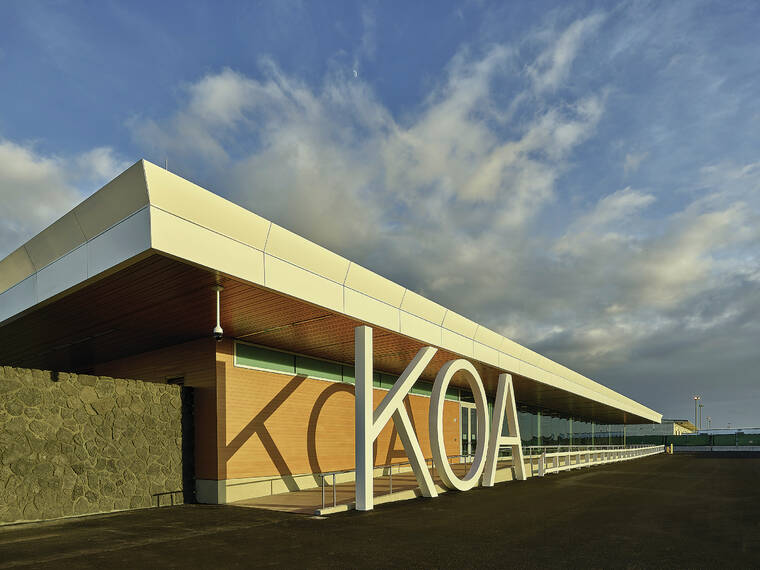Construction of a permanent Federal Inspection Services facility to allow for continued international arrivals beyond this year at Ellison Onizuka Kona International Airport at Keahole has been completed under budget and ahead of schedule.
The final price tag for the facility, which comprises the 32,700-square-foot Federal Inspection Services building, covered wait area, and a 7,000-square-foot enclosed holdroom, was $58.7 million, about $700,000 under the contract amount awarded to Nan Inc., according to the state Department of Transportation.
The work was also completed about two months ahead of a December 2021 deadline set in 2016 when the state reached an agreement with U.S. Customs and Border Protection that allowed the airport to continue using a temporary tent first established in June 1996 through December.
“The completion of this permanent home for our partners at Customs and Border Patrol fulfills one of my top priorities, which was to establish a second Federal Inspection Service in Kona. One daily flight from Japan can generate over $100 million in annual visitor spending on Hawaii Island, bring in over $10 million in state tax revenue, and support 1,200 jobs,” said Gov. David Ige.
Over the past couple of weeks, U.S. Customs and Border Protection staff have been moving into the new digs located on the southern end of the airport, said Chauncey Wong Yuen, Hawaii district manager for the state Department of Transportation’s Airports Division. A blessing ceremony is slated for today.
“For the most part, they are in the new building. Now, we’re just waiting for the traffic to return,” Wong Yuen said referring to international travel that ground to a halt amid the pandemic. “Japan Airlines has already given us next year, early spring, that they will be ready to return, but it just depends on the quarantine conditions.”
While Hawaii has allowed international travel from some countries for fully vaccinated travelers and those who can provide proof of a pre-flight COVID-19 test — including Japan, Korea, Taiwan, Canada, Tahiti and the Philippines — travel numbers have been low due to quarantine requirements in traveler’s home countries. For example, Japan currently requires all citizens to test and quarantine for 10 days after travel regardless of vaccination status.
Wong Yuen said Kona hasn’t welcomed an international flight since early 2020, when the pandemic took hold and travel restrictions began being implemented. Flights to and from Japan were the only ones using the facility as flights from Canada clear customs before departing the country.
Prior to COVID, in October 2019, the airport saw nearly 14,000 arrivals from Japan. That year, nearly 131,000 Japanese travelers came through the airport. Through the end of August of this year, 73 travelers have come through the airport after clearing customs in Honolulu, up from one traveler at this point in 2020.
The Federal Inspection Services facility needed to be completed by the end of 2021 as agreed on by the state and U.S. Customs and Border Protection in December 2016. That agreement permitted the airport to continue using — for up to five years — the white tent currently housing the Federal Inspection Station, allowing for the resumption of international direct flights to the airport.
Until the agreement in December 2016, customs and immigration officials hadn’t been stationed at the airport’s international tent since Japan Airlines stopped flying to Kona in 2010. A temporary practice of having charter flights reimburse Customs for flying agents from Honolulu to Kona to staff the customs gateway there was ended in 2012.
“After JAL did first pull out in 2010 they made clear to us that if somehow Japan came back in the future, we would have to have a new facility — we wouldn’t be able to use the old facility — Customs has a specific set of standards and would not serve Kona without those being met,” he said.
Carol Torigoe, president and CEO of KYA Inc., the architectural firm hired to design the buildings, and Senior Principal Kyle Wang said the design seeks to “enhance comfort without losing what everybody loves about Ellison Onizuka Kona International Airport.”
“It’s a slight departure from the original in that we have to bring a new era into the airport as we bring in new modern conveniences,” said Torigoe.
According to KYA Inc., the LEED Silver facility is built for future expansion, including the ability to add a second floor concourse as well as a second baggage claim unit.
Upon opening, the FIS facility will be able to accommodate one arriving flight, moving passengers through at a rate of 400 persons per hour. Expansion could accommodate two flights at one time with an throughput level of 600 passengers per hour.
The facility’s 7,000-square-foot enclosed holdroom, also provides an additional gate for the airport to use for domestic flights bringing the total number of gates to 11.






